NGC 4755 : THE JEWEL BOX
|
|||||||||
|
Although often only just labelled
among all the deep-sky objects as the cold an inelegantly designation
of NGC 4755, from the New General Catalogue, this truly
brilliant collection of stars, nonetheless, has absolutely thrilled
all southern telescopic observers for almost two centuries. Sometimes
named just as the Kappa Crucis Cluster or as the more
affectionate and popular namesake; The Jewel Box.
This latter description certainly does conjure up in the imagination
of some fabulous King’s or
Queen’s gold and jewel-encrusted
crown or of some hidden cave of treasure back in the times of
Aladdin and the Arabian Nights. Although the many component
stars are certainly not made from sparkling gems of rubies, diamonds,
emeralds, or sapphires, its numerous colourful components never fail
to capture the heart of the telescopist on some cold and windy winter
night in some southern backyard or field. Many modern writers have
kept this traditional illusion of these wonderful jewelled stars in
the nighttime sky, but others have modernised this somewhat
diminished view, by even compared this cluster’s appearance to some celestial set of
Traffic Lights. Although the cluster might not be really like
this — perhaps given based on the line of the three stars at
the heart of the cluster that has given its name. Yet such common
names are quite ideal for younger childre n that have received their
first telescope or binoculars — so perhaps this newer
description is more realistic based on their own daily experiences
— thus remaining much easier to digest and understand. |
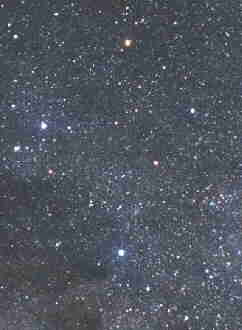
Figure 1: “Crux and the Jewel Box” Image showing the Southern Cross and its famous ‘ Jewel Box’ (center far left) — being roughly southeast of 1.3 magnitude star β Crucis and lying just northeast of the dark nebula, commonly known as the Coalsack. (See bottom-left) |
|
APPEARANCE of the JEWEL BOX
Kappa Crucis cluster itself is placed within the boundaries of the famous Southern Cross or Crux, which happens to be the smallest of the eighty-eight constellations that contains the highest concentration of bright stars per unit area than anywhere else in the sky. NGC 4755 appears within the western part of the constellation, being quite near the Cross’s and is placed merely 28′E from the Centaurus-Crux border. Alternatively this cluster is either 0.7°SE (40′) of the second brightest star of the Cross — the 2nd magnitude Beta Crucis / β Cru or some 42′NNW (PA 340°) from the edge of the Coal Sack. The Jewel Box is so bright that we can see it with the naked-eye as some “hazy star” of 4.2 visual magnitude. From this it retains Bayer’s designation of kappa — Kappa Crucis Although the ‘A’-shaped asterism of bright stars dominates the Jewel Box, in binoculars it is not uncommon to see some six or seven stars.
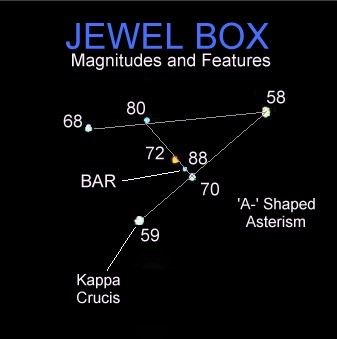
Figure 2. Bright Stars of The Jewel Box This shows the cluster’s brightness and the bar-like feature in the telescopic A-shaped asterism. The stars here can be readily seen without difficulty in 7×50 binoculars. To do this it would be best to mount the binoculars on a solid tripod, as the Jewel Box is only 10 arcmin or 1⁄6th of one degree or roughly third the diameter of the Moon. The star marked “88” is 8.88 magnitude, which I find as a suitable test of the conditions. Directions: north is up, east is left.
The entire cluster is clearly revealed in most amateur telescopes, displaying anywhere between fifty and about one hundred and fifty stars. In even larger apertures it becomes gaspingly beautiful — seeing a delightful mixture of the bright stars interspersed with about one hundred fainter stars towards the south to southeast of the heart of the cluster. Amazingly these are all seem tightly compacted within its small confined 10 arc minute size.
Earlier observers often confused with this odd differences between the few bright colourful stars and the huge conglomeration of faint ones, and for sometime an postulate was entertained that this might actually be two different clusters superimposed on top of each other. It has been even speculated that the brighter stars were the closest of the cluster. Today, this seems to be not the case. (2010) Differences are thought to be caused by simple perspective or during the evolutionary times when the cluster was first formed. Yet visually the majority of stars do indeed appear well outside the main asterism — so most of the remaining multitudes of fainter stars lie towards the cluster’s south or south-western boundary.
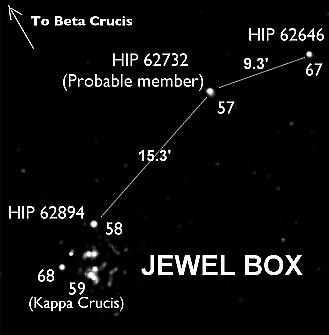
Figure 3. Outer Regions of The Jewel
Box This shows the Outer Regions of the Jewel Box and
includes the naked-eye blue star HIP 62732, which displays
the same proper motions as all the open cluster stars. If this is
truly a member, then it is brightest star of NGC 4755, even though
it is some 15.3 arcmin from the peak of the ‘A’ in the
Jewel Box. The other yellowish star, HIP 62646, is not a
member. However, it can be used to identify the star HIP 62732.
Additional studies have further shown that other fainter stars may
extend towards the south (roughly in the bottom right of Fig. 3.)
The orientation of the Figure is East to West (East being at the top
of the Figure.)
BRIGHTNESS of Star in N.G.C. 4755
Distribution of stellar magnitudes of NGC 4755 and other star clusters plays significantly with the overall cluster appearance. For NGC 4755 there are five stars brighter than 7th magnitude, eight above 8th, fifteen above 9th, thirty-five above 10th. Yet between 9.5 and 12.0 magnitude there is a significant drop in star count, before the numbers again rise exponentially. This cut-off falls near the magnitude limit of 10.5cm and is no optical illusion. No wonder that observers using small apertures only see the bright stars of the cluster — and are perhaps slightly disappointed. By increasing the aperture to either 20cm or 25cm, suddenly reveals this significant leap with additional stars, and so, roughly about eighty stars will be seen. Any 30cm will see about ninety stars. Even larger apertures reveal stars down to 16th magnitude — counting perhaps as many as 135 to 145 stars.
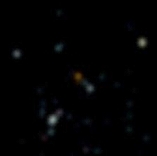 |
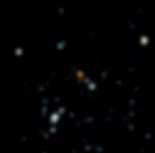 |
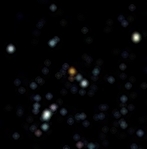 |
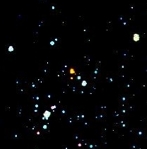 |
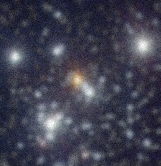 |
Figs. 4 through 8 : Images of the
Jewel Box Through Various Apertures.
Top Left is
Binoculars to 5cm : Top Right is 7.5cm. Then
moving to the second row, these are for; 15cm (Left)
20cm (Middle) and 30cm to 40cm
(Right).
Here all these figures show that the number of stars does gradually increases with telescopic aperture. This simply depends on the magnitude limit at your location, and of course, the current weather and seeing conditions.
Somewhere between 20cm and 30cm the numbers of stars rises more dramatically when the fainter stars are then revealed. The reason for this is mentioned in the above text but also under the discussion of the cluster’s Colour-Magnitude Diagram. Furthermore, the relative star sizes in the images here have been organised to be roughly the same, but in actuality, the telescope would need much higher magnification as the aperture used decreases in size.
Last Update : 24th April 2016
Southern Astronomical Delights © (2016)



